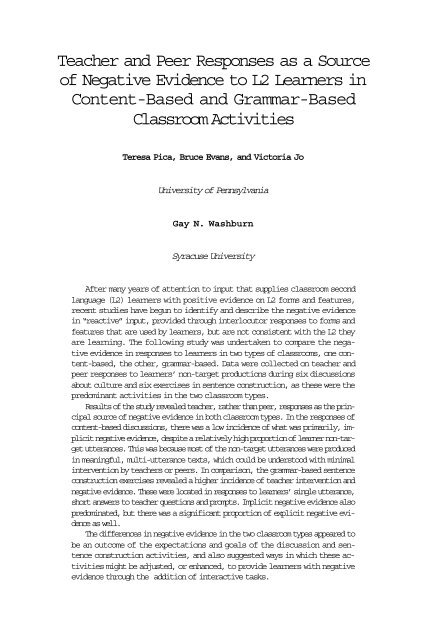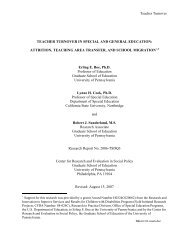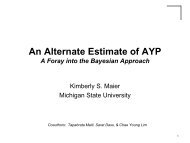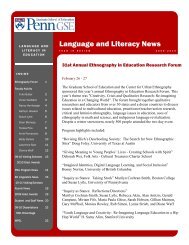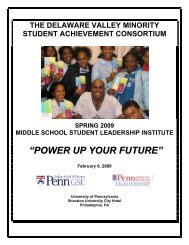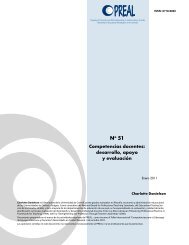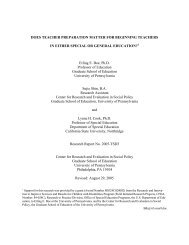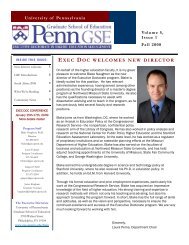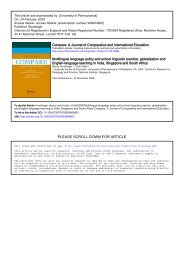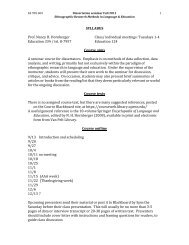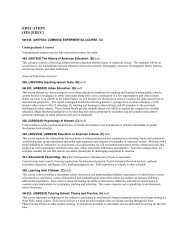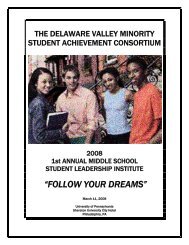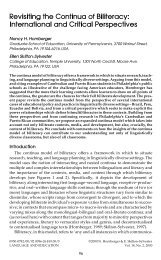Teacher and Peer Responses as a Source of Negative Evidence to ...
Teacher and Peer Responses as a Source of Negative Evidence to ...
Teacher and Peer Responses as a Source of Negative Evidence to ...
You also want an ePaper? Increase the reach of your titles
YUMPU automatically turns print PDFs into web optimized ePapers that Google loves.
<strong>Teacher</strong> <strong>and</strong> <strong>Peer</strong> <strong>Responses</strong> <strong>as</strong> a <strong>Source</strong><br />
<strong>of</strong> <strong>Negative</strong> <strong>Evidence</strong> <strong>to</strong> L2 Learners in<br />
Content-B<strong>as</strong>ed <strong>and</strong> Grammar-B<strong>as</strong>ed<br />
Cl<strong>as</strong>sroom Activities<br />
Teresa Pica, Bruce Evans, <strong>and</strong> Vic<strong>to</strong>ria Jo<br />
University <strong>of</strong> Pennsylvania<br />
Gay N. W<strong>as</strong>hburn<br />
Syracuse University<br />
After many years <strong>of</strong> attention <strong>to</strong> input that supplies cl<strong>as</strong>sroom second<br />
language (L2) learners with positive evidence on L2 forms <strong>and</strong> features,<br />
recent studies have begun <strong>to</strong> identify <strong>and</strong> describe the negative evidence<br />
in “reactive” input, provided through interlocu<strong>to</strong>r responses <strong>to</strong> forms <strong>and</strong><br />
features that are used by learners, but are not consistent with the L2 they<br />
are learning. The following study w<strong>as</strong> undertaken <strong>to</strong> compare the negative<br />
evidence in responses <strong>to</strong> learners in two types <strong>of</strong> cl<strong>as</strong>srooms, one content-b<strong>as</strong>ed,<br />
the other, grammar-b<strong>as</strong>ed. Data were collected on teacher <strong>and</strong><br />
peer responses <strong>to</strong> learners’ non-target productions during six discussions<br />
about culture <strong>and</strong> six exercises in sentence construction, <strong>as</strong> these were the<br />
predominant activities in the two cl<strong>as</strong>sroom types.<br />
Results <strong>of</strong> the study revealed teacher, rather than peer, responses <strong>as</strong> the principal<br />
source <strong>of</strong> negative evidence in both cl<strong>as</strong>sroom types. In the responses <strong>of</strong><br />
content-b<strong>as</strong>ed discussions, there w<strong>as</strong> a low incidence <strong>of</strong> what w<strong>as</strong> primarily, implicit<br />
negative evidence, despite a relatively high proportion <strong>of</strong> learner non-target<br />
utterances. This w<strong>as</strong> because most <strong>of</strong> the non-target utterances were produced<br />
in meaningful, multi-utterance texts, which could be unders<strong>to</strong>od with minimal<br />
intervention by teachers or peers. In comparison, the grammar-b<strong>as</strong>ed sentence<br />
construction exercises revealed a higher incidence <strong>of</strong> teacher intervention <strong>and</strong><br />
negative evidence. These were located in responses <strong>to</strong> learners’ single utterance,<br />
short answers <strong>to</strong> teacher questions <strong>and</strong> prompts. Implicit negative evidence also<br />
predominated, but there w<strong>as</strong> a significant proportion <strong>of</strong> explicit negative evidence<br />
<strong>as</strong> well.<br />
The differences in negative evidence in the two cl<strong>as</strong>sroom types appeared <strong>to</strong><br />
be an outcome <strong>of</strong> the expectations <strong>and</strong> goals <strong>of</strong> the discussion <strong>and</strong> sentence<br />
construction activities, <strong>and</strong> also suggested ways in which these activities<br />
might be adjusted, or enhanced, <strong>to</strong> provide learners with negative<br />
evidence through the addition <strong>of</strong> interactive t<strong>as</strong>ks.
WORKING PAPERS IN EDUCATIONAL LINGUISTICS<br />
Input <strong>and</strong> <strong>Evidence</strong> in Second Language Learning<br />
That second language (L2) learners need input for their learning is<br />
fundamental <strong>to</strong> second language acquisition theory <strong>and</strong> language<br />
pedagogy. Research over the p<strong>as</strong>t two decades h<strong>as</strong> addressed<br />
questions about the exact form <strong>and</strong> content <strong>of</strong> the input that learners need,<br />
<strong>and</strong> its degrees <strong>of</strong> frequency <strong>and</strong> timing in the learning process. (See Ellis<br />
1994; G<strong>as</strong>s & Selinker 1994; Lightbown & Spada 1999; Long 1996; Pica 1994,<br />
<strong>and</strong> Swain 1995 for syntheses <strong>of</strong> this work). More recently, new questions<br />
have emerged about the input needed by second language (L2) learners.<br />
These have focused on the evidence they require about the forms <strong>and</strong> features<br />
<strong>of</strong> the L2 they are learning.<br />
Long h<strong>as</strong> addressed these questions in terms <strong>of</strong> the positive <strong>and</strong> negative evidence<br />
available in input. By drawing from first language learning theory <strong>and</strong> research<br />
(including Farrar 1990, 1992; Nelson 1977; <strong>and</strong> Pinker 1989, for example)<br />
<strong>and</strong> from studies <strong>of</strong> L2 cl<strong>as</strong>sroom intervention (such <strong>as</strong> those <strong>of</strong> Spada<br />
& Lightbown 1993; White 1991; <strong>and</strong> White, Spada, Lightbown & Ranta 1991),<br />
he distinguished between input that provides positive evidence <strong>of</strong> forms<br />
<strong>and</strong> features that comply with those <strong>of</strong> the L2, <strong>and</strong> input that supplies negative<br />
evidence on forms <strong>and</strong> features that are used by learners, but are not<br />
consistent with the L2 they are learning. (For a comprehensive review, see<br />
Long 1996).<br />
Both positive <strong>and</strong> negative evidence can be made available through formal rule<br />
instruction, grammar texts, <strong>and</strong> other related resources. However, one <strong>of</strong> the most<br />
effective ways in which evidence can be revealed <strong>to</strong> learners is through what Long<br />
called ‘reactive’ input, provided through interlocu<strong>to</strong>r responses <strong>to</strong> learner imprecisions<br />
within the context <strong>of</strong> meaningful interaction. This is particularly the c<strong>as</strong>e for<br />
negative evidence. In situating their questions <strong>and</strong> examining their findings within<br />
this perspective, Long <strong>and</strong> other researchers have both underscored the importance<br />
<strong>of</strong> input that <strong>of</strong>fers positive L2 evidence, <strong>and</strong> shed light on the contributions <strong>of</strong><br />
‘reactive’ input that supplies negative evidence <strong>to</strong> the learning process. (See for<br />
example, a review article by Spada 1997, <strong>and</strong> research <strong>of</strong> Doughty & Varela<br />
1998; Lightbown 1993; Lightbown & Spada 1997; Long, Inagaki, & Ortega<br />
1998; Long & Robinson 1998; Lyster 1998; Lyster & Ranta 1997; Mackey &<br />
Philp 1998; Oliver 1995; <strong>and</strong> again, Spada & Lightbown 1993; White 1991;<br />
<strong>and</strong> White, Spada, Lightbown & Ranta 1991).<br />
This small sample represents a larger pool <strong>of</strong> studies whose findings have shed<br />
light on the diversity <strong>of</strong> evidence available in input <strong>to</strong> learners <strong>and</strong> on the exp<strong>and</strong>ed<br />
role <strong>of</strong> responses <strong>to</strong> learners <strong>as</strong> a vehicle for such input. They further illustrate<br />
the role <strong>of</strong> meaningful interaction in the learning process, <strong>and</strong> suggest<br />
the need <strong>to</strong> examine the cl<strong>as</strong>sroom environment in such terms. The following<br />
section will review the distinguishing characteristics <strong>of</strong> positive <strong>and</strong><br />
negative evidence that have been identified <strong>and</strong> described in these studies,<br />
<strong>and</strong> will illustrate how this work h<strong>as</strong> motivated the present investigation<br />
in<strong>to</strong> cl<strong>as</strong>sroom responses <strong>to</strong> learners <strong>as</strong> sources <strong>of</strong> negative evidence.<br />
2
SOURCES OF NEGATIVE EVIDENCE IN CLASSROOM ACTIVITIES<br />
Positive <strong>and</strong> <strong>Negative</strong> <strong>Evidence</strong><br />
According <strong>to</strong> Long, positive L2 evidence is found in utterances <strong>and</strong> texts<br />
available in input <strong>to</strong> learners during their interaction with interlocu<strong>to</strong>rs. As<br />
illustrated in Figure 1, these samples <strong>of</strong> input can occur in their authentic,<br />
unaltered state, <strong>as</strong> in (1a), or they can be modified when they cannot be<br />
unders<strong>to</strong>od by the learner, <strong>as</strong> illustrated in (1a) - (1e). As shown in underlined<br />
form, individual target productions <strong>of</strong> words or phr<strong>as</strong>es might be<br />
extracted by interlocu<strong>to</strong>rs from their original utterances, <strong>and</strong> provided in<br />
follow up utterances either in isolation, <strong>as</strong> in (1b) or embedded in longer<br />
units, <strong>as</strong> in (1c). Words <strong>and</strong> phr<strong>as</strong>es might be repeated, or rephr<strong>as</strong>ed, with<br />
pronoun substitutions, <strong>and</strong> definitions <strong>and</strong> examples added <strong>to</strong> them, <strong>as</strong><br />
shown in underlined bold in (1c) - (1f).<br />
Figure 1<br />
English L2 Learner<br />
When is the cl<strong>as</strong>s?<br />
I don’t underst<strong>and</strong><br />
NS English Interlocu<strong>to</strong>r<br />
(1a) The cl<strong>as</strong>s begins at two<br />
(1b) at two<br />
(1c) About the cl<strong>as</strong>s, it begins at two.<br />
(1d) It begins at two.<br />
(1e) It begins exactly at two o’clock.<br />
(1f) Ah the cl<strong>as</strong>s on film begins at 2.<br />
These kinds <strong>of</strong> adjustments not only <strong>as</strong>sist learners in their comprehension <strong>of</strong><br />
L2 input, but also allow them additional, more focused, opportunities <strong>to</strong> attend <strong>to</strong><br />
L2 forms which encode meanings <strong>and</strong> functions in the input. (See also Pica 1994).<br />
Together, authentic <strong>and</strong> modified input are believed <strong>to</strong> provide much <strong>of</strong> the positive,<br />
linguistic evidence needed for L2 learning. Yet, <strong>as</strong> Long (1996) h<strong>as</strong> pointed<br />
out, such input is an insufficient source <strong>of</strong> evidence for learners. First, learners<br />
may not notice L2 forms <strong>and</strong> features that are difficult, complex, or highly similar<br />
<strong>to</strong> their L1, even when they are encoded in modified input. Secondly, they might<br />
not notice the difference between target versions <strong>of</strong> L2 forms <strong>and</strong> features in the<br />
input <strong>and</strong> their own erroneous interlanguage versions <strong>of</strong> them. This is especially<br />
the c<strong>as</strong>e if they have internalized inaccurate versions <strong>of</strong> L2 forms <strong>and</strong> features,<br />
especially those that are functionally adequate for communicative purposes. (See<br />
also Doughty & Williams 1998 <strong>and</strong> Schmidt 1990).<br />
To help learners access, <strong>and</strong> eventually internalize, target versions <strong>of</strong> L2 forms,<br />
negative evidence about what is NOT in the L2 can be especially useful.<br />
Such evidence can help learners notice differences between developmental<br />
features <strong>of</strong> their interlanguage <strong>and</strong> target features <strong>of</strong> the L2 (See again,<br />
Schmidt 1990 for data <strong>and</strong> discussion). <strong>Negative</strong> evidence can keep learners<br />
from stabilizing erroneous, developmental forms <strong>and</strong> features in their<br />
interlanguage, or can help them destabilize errors should such a point <strong>of</strong><br />
stabilization have already occurred.<br />
That negative evidence can be provided through formal instruction <strong>and</strong><br />
corrective feedback h<strong>as</strong> long been documented in cl<strong>as</strong>sroom studies (See<br />
3
WORKING PAPERS IN EDUCATIONAL LINGUISTICS<br />
research <strong>and</strong> review <strong>of</strong> research in Chaudron 1977 <strong>and</strong> 1988). What is remarkable,<br />
however, <strong>as</strong> illustrated in Long’s construct <strong>of</strong> “reactive input,” is<br />
its abundance in responses <strong>to</strong> learners during conversational interaction.<br />
Examples <strong>of</strong> such responses are provided below, in Figure 2.<br />
As shown in italics in Figure 2, items (2a) - (2f), conversational responses can<br />
<strong>of</strong>fer learners implicit negative evidence through statements <strong>and</strong> questions regarding<br />
the responder’s need for message comprehensibility, clarification, <strong>and</strong> confirmation.<br />
Often, target L2 versions <strong>of</strong> errorful words <strong>and</strong> phr<strong>as</strong>es are included, <strong>as</strong> is<br />
the c<strong>as</strong>e for begins in (2d) - (2f). Researchers have referred <strong>to</strong> such responses <strong>as</strong><br />
signals for the negotiation <strong>of</strong> meaning (See Long 1985, 1996; G<strong>as</strong>s & Varonis<br />
1989, 1994; <strong>and</strong> Pica 1988, 1994) <strong>and</strong> signals for the negotiation <strong>of</strong> form (See<br />
Lyster 1998, <strong>and</strong> Lyster & Ranta 1997).<br />
Other responses, such <strong>as</strong> (2g) <strong>and</strong> (2h), exp<strong>and</strong> or rec<strong>as</strong>t erroneous utterances,<br />
replacing them with L2 versions. They, <strong>to</strong>o, <strong>of</strong>fer implicit negative evidence, alerting<br />
learners subtly <strong>to</strong> imprecisions in the meaning <strong>of</strong> their messages, <strong>as</strong> they recode<br />
erroneous forms within them. As such, they function quite differently from the<br />
responses <strong>of</strong> (2i) - (2k), which also recode erroneous forms, but do so through<br />
explicit correction <strong>and</strong> instructional, metalinguistic input.<br />
Figure 2<br />
English L2 Learner<br />
The cl<strong>as</strong>s begin on two.<br />
NNS English Interlocu<strong>to</strong>r<br />
(2a) I didn’t underst<strong>and</strong><br />
(2b) What did you say?<br />
(2c) What’s the cl<strong>as</strong>s?<br />
(2d) The cl<strong>as</strong>s begins when?<br />
(2e) It begins when?<br />
(2f) It begins at what time?<br />
(2g) Ah the cl<strong>as</strong>s on film begins at two<br />
(2h) The cl<strong>as</strong>s begins at two<br />
(2i) You need <strong>to</strong> say that the cl<strong>as</strong>s begins at two<br />
(2j) You need <strong>to</strong> add -s <strong>to</strong> begin<br />
(2k) Cl<strong>as</strong>s is singular. So you need <strong>to</strong> make begin agree<br />
withit<br />
As the above examples illustrate, negative evidence about L2 form <strong>and</strong> meaning<br />
can be made available <strong>to</strong> L2 learners across a range <strong>of</strong> functionally diverse<br />
responses, with varying degrees <strong>of</strong> explicitness. Whether such availability <strong>and</strong> variation<br />
are also apparent in the cl<strong>as</strong>sroom w<strong>as</strong> the focus <strong>of</strong> the following study.<br />
This study aimed <strong>to</strong> describe <strong>and</strong> compare responses <strong>of</strong> negative evidence<br />
in two types <strong>of</strong> cl<strong>as</strong>srooms — those whose underlying curriculum, materials,<br />
<strong>and</strong> activities emph<strong>as</strong>ized L2 communication <strong>and</strong> academic content<br />
<strong>and</strong> those which emph<strong>as</strong>ized the application <strong>of</strong> rules <strong>and</strong> formal accuracy.<br />
Specific concerns focused on similarities <strong>and</strong> differences in the cl<strong>as</strong>srooms<br />
with respect <strong>to</strong> the extent <strong>to</strong> which negative evidence w<strong>as</strong> <strong>of</strong>fered in responses<br />
<strong>to</strong> learners’ non-target productions; w<strong>as</strong> provided by teachers or<br />
peers; <strong>and</strong> w<strong>as</strong> encoded in an implicit or explicit manner.<br />
These concerns were heightened by the current post method period <strong>of</strong> L2<br />
4
SOURCES OF NEGATIVE EVIDENCE IN CLASSROOM ACTIVITIES<br />
teaching, in which teachers, curriculum planners, <strong>and</strong> other language educa<strong>to</strong>rs<br />
might choose from a range <strong>of</strong> pedagogical options in guiding the<br />
acquisition <strong>of</strong> L2 form <strong>and</strong> function. (See discussion in Kumaravadivelu<br />
1994 <strong>and</strong> Pica 2000). A further influence w<strong>as</strong> the tendency <strong>to</strong>ward <strong>of</strong>fering<br />
specialized <strong>and</strong> elective courses, particularly at the university level. Such<br />
specialization suggested that negative evidence may be represented very<br />
differently <strong>to</strong> learners, depending on the types <strong>of</strong> cl<strong>as</strong>ses they take.<br />
In its focus on the incidence <strong>and</strong> features <strong>of</strong> negative evidence across two different<br />
types <strong>of</strong> cl<strong>as</strong>sroom contexts, the study w<strong>as</strong> also informed by the growing<br />
body <strong>of</strong> research that h<strong>as</strong> connected negative evidence, cl<strong>as</strong>sroom t<strong>as</strong>ks, <strong>and</strong> learning<br />
outcomes. (See, for example, Doughty <strong>and</strong> Varela 1998; Lightbown <strong>and</strong><br />
Spada 1990; Lyster 1998; Lyster <strong>and</strong> Ranta 1997; Oliver 1995, 2000). This<br />
made it essential <strong>to</strong> identify specific cl<strong>as</strong>sroom activities within each context<br />
<strong>as</strong> a b<strong>as</strong>is for analysis. These methodological matters are discussed in the<br />
following section, which includes a description <strong>of</strong> the cl<strong>as</strong>sroom contexts,<br />
participants, <strong>and</strong> cl<strong>as</strong>sroom activities <strong>of</strong> the study.<br />
Cl<strong>as</strong>sroom Contexts<br />
Method<br />
Data for the two types <strong>of</strong> cl<strong>as</strong>sroom contexts were gathered in an intensive,<br />
university b<strong>as</strong>ed English language institute. The cl<strong>as</strong>ses, which were drawn from<br />
courses in content <strong>and</strong> grammar, met in one <strong>to</strong> two hour blocks <strong>of</strong> time four <strong>to</strong> five<br />
times a week, over a seven week period.<br />
Six content-b<strong>as</strong>ed cl<strong>as</strong>s meetings were studied. Three <strong>of</strong> the cl<strong>as</strong>ses focused on<br />
literature <strong>and</strong> culture, <strong>as</strong> students read <strong>and</strong> responded <strong>to</strong> American English<br />
literary texts. The other three cl<strong>as</strong>ses focused on film <strong>and</strong> American culture,<br />
<strong>and</strong> used tapes <strong>of</strong> recent U.S. movies <strong>as</strong> its a b<strong>as</strong>is for its content. Their<br />
primary objective w<strong>as</strong> <strong>to</strong> promote the learning <strong>of</strong> English L2 <strong>and</strong> knowledge<br />
about American cultures. Each content-b<strong>as</strong>ed cl<strong>as</strong>s had access <strong>to</strong> a detailed<br />
curriculum guide, which w<strong>as</strong> the outcome <strong>of</strong> efforts among curriculum developers,<br />
various course instruc<strong>to</strong>rs, <strong>and</strong> language institute direc<strong>to</strong>rs. Both<br />
the literature <strong>and</strong> film curricula emph<strong>as</strong>ized a range <strong>of</strong> interactional activities<br />
among teachers <strong>and</strong> students, including cl<strong>as</strong>s discussion, dialogue journals,<br />
student group work, at home projects <strong>and</strong> reading, <strong>and</strong> in-cl<strong>as</strong>s presentation.<br />
Grammar lessons were provided <strong>as</strong> the teachers deemed necessary,<br />
both in cl<strong>as</strong>s, <strong>and</strong> in feedback on homework <strong>as</strong>signments.<br />
Six grammar-b<strong>as</strong>ed cl<strong>as</strong>s meetings were also studied. Four <strong>of</strong> the cl<strong>as</strong>ses were<br />
at an intermediate level, <strong>and</strong> two were at an advanced level. Both held <strong>as</strong> their<br />
primary objective the underst<strong>and</strong>ing, application, <strong>and</strong> development <strong>of</strong> rules <strong>and</strong><br />
structures <strong>of</strong> English grammar. Each cl<strong>as</strong>s had access <strong>to</strong> a detailed curriculum<br />
guide, which emph<strong>as</strong>ized interaction among teachers <strong>and</strong> students,<br />
using grammar in meaningful contexts, <strong>and</strong> homework preparation for<br />
5
WORKING PAPERS IN EDUCATIONAL LINGUISTICS<br />
cl<strong>as</strong>s activities.<br />
Participants<br />
There were three content b<strong>as</strong>ed <strong>and</strong> three grammar-b<strong>as</strong>ed teachers, all<br />
with relevant pr<strong>of</strong>essional training <strong>and</strong> experience, ranging from exceptional<br />
<strong>to</strong> appropriate <strong>and</strong> sufficient. Two <strong>of</strong> the content-b<strong>as</strong>ed teachers <strong>and</strong> two <strong>of</strong><br />
the grammar-b<strong>as</strong>ed teachers had specific training <strong>and</strong> education in applied<br />
linguistics <strong>and</strong> experience with the curriculum they were teaching. The other<br />
two teachers were less experienced, but considered highly qualified <strong>to</strong> teach<br />
their respective are<strong>as</strong>.<br />
The students were at advanced <strong>and</strong> high intermediate levels <strong>of</strong> English L2 development.<br />
In the literature cl<strong>as</strong>s, a wide range <strong>of</strong> Asian <strong>and</strong> European L1 backgrounds<br />
<strong>and</strong> ethnicities w<strong>as</strong> represented. Students in the film <strong>and</strong> grammar cl<strong>as</strong>ses<br />
were predominantly <strong>of</strong> Asian L1 backgrounds <strong>and</strong> ethnicities. There were ten <strong>to</strong><br />
fifteen students per cl<strong>as</strong>s.<br />
Results <strong>of</strong> placement <strong>and</strong> pr<strong>of</strong>iciency tests, <strong>as</strong> well <strong>as</strong> reports <strong>and</strong> observations<br />
<strong>of</strong> teachers <strong>and</strong> program administra<strong>to</strong>rs, revealed an overall level <strong>of</strong> communicative<br />
pr<strong>of</strong>iciency for students consistent with their level placements. Despite<br />
their overall level <strong>of</strong> communicative pr<strong>of</strong>iciency, however, the students<br />
also revealed grammatical imprecisions <strong>and</strong> inconsistencies in their expression<br />
<strong>of</strong> reference, modality, <strong>and</strong> information structure, <strong>as</strong> seen in their article<br />
over-, <strong>and</strong> under-suppliance, inappropriate verb tense <strong>and</strong> <strong>as</strong>pect marking,<br />
<strong>and</strong> modal mis-selection. Some <strong>of</strong> these imprecisions were addressed explicitly<br />
in the grammar courses. In the content-b<strong>as</strong>ed courses, these features<br />
were not emph<strong>as</strong>ized directly in the curricula, but were believed <strong>to</strong> be widely<br />
available in oral <strong>and</strong> written cl<strong>as</strong>sroom input <strong>and</strong> could be addressed in<br />
individual cl<strong>as</strong>ses if deemed necessary by the individual teacher.<br />
Data Collection<br />
Data collection w<strong>as</strong> carried out through audio <strong>and</strong> video taping. In the content-b<strong>as</strong>ed<br />
cl<strong>as</strong>ses, data were collected during teacher-directed discussions <strong>of</strong> literary<br />
texts <strong>and</strong> film, which were b<strong>as</strong>ed on preparation through homework reading<br />
<strong>as</strong>signments, previewing, <strong>and</strong> re-viewing. The activities used <strong>to</strong> gather data on the<br />
grammar-b<strong>as</strong>ed cl<strong>as</strong>ses were teacher-led sentence construction exercises, <strong>of</strong>ten b<strong>as</strong>ed<br />
on homework <strong>as</strong> well. They varied from half <strong>to</strong> three-fourths <strong>of</strong> each cl<strong>as</strong>s meeting<br />
time, <strong>as</strong> other portions <strong>of</strong> cl<strong>as</strong>s time were used for cl<strong>as</strong>sroom management <strong>and</strong>, in<br />
the c<strong>as</strong>e <strong>of</strong> the content-b<strong>as</strong>ed cl<strong>as</strong>ses, periodic text re-reading or film re-viewing <strong>to</strong><br />
support opinions <strong>and</strong> answers. Both activities were chosen <strong>as</strong> primary units<br />
for data collection <strong>and</strong> analysis because <strong>of</strong> their frequency <strong>of</strong> occurrence,<br />
uniformity <strong>of</strong> interactional structure, <strong>and</strong> repeated use in the cl<strong>as</strong>srooms<br />
under study, <strong>as</strong> revealed during several months <strong>of</strong> prior cl<strong>as</strong>sroom observation.<br />
The discussion activity focused on exchange <strong>of</strong> information, opinions <strong>and</strong> cultural<br />
insights in<strong>to</strong> the text or film content. These were chosen at r<strong>and</strong>om<br />
6
SOURCES OF NEGATIVE EVIDENCE IN CLASSROOM ACTIVITIES<br />
from a sample <strong>of</strong> more than thirty such activities, each initiated through<br />
framing utterances such <strong>as</strong>, “I’d like <strong>to</strong> talk about...” or “Let’s go on <strong>to</strong>... .”<br />
This framing utterance served <strong>as</strong> the initial boundary for the activity. The<br />
final boundary w<strong>as</strong> marked either by the end <strong>of</strong> the cl<strong>as</strong>s meeting or a teacher<br />
utterance such <strong>as</strong>, “OK, let’s move on <strong>to</strong>...”<br />
The sentence construction exercises required student application <strong>of</strong> specific<br />
grammar structures <strong>to</strong> prompts from the teacher or text. The purpose<br />
<strong>of</strong> this activity w<strong>as</strong> <strong>to</strong> create what were considered correct sentences by<br />
filling in the blanks in sentence exercises, responding <strong>to</strong> a stimulus picture<br />
or text, or forming sentences by type. These activities were identified not<br />
only by these features, but also in the ways they were introduced by the<br />
teachers through structuring remarks such <strong>as</strong> “Your <strong>as</strong>signment for <strong>to</strong>day<br />
w<strong>as</strong> <strong>to</strong>...,” “let’s go over those,” or "Let me just play a little game for a<br />
minute..." “So I want <strong>to</strong> practice...”<br />
Data Coding <strong>and</strong> Analysis<br />
All data from the discussion <strong>and</strong> exercise activities were first coded for teacher<br />
<strong>and</strong> student utterances. R<strong>and</strong>om samples <strong>of</strong> the data were coded by the researcher<br />
<strong>and</strong> trained coders, each with backgrounds in applied linguistics. Inter-item reliability<br />
w<strong>as</strong> .98 for utterances, <strong>and</strong> ranged between .80 <strong>and</strong> .99, for features <strong>of</strong><br />
negative evidence <strong>and</strong> other features, whose operationalization, coding, <strong>and</strong> computing<br />
appear in the list which follows.<br />
1. Learner non-target productions: These were student-produced utterances<br />
that did not conform <strong>to</strong> target relationships <strong>of</strong> L2 form, function,<br />
<strong>and</strong> meaning. Computations were made <strong>of</strong> their frequency <strong>and</strong> proportion <strong>to</strong><br />
the <strong>to</strong>tal frequency <strong>of</strong> learner utterances.<br />
2. <strong>Teacher</strong> <strong>and</strong> <strong>Peer</strong> responses that followed learner non-target productions.<br />
These were utterances that followed immediately after learner nontarget<br />
utterances. Computations were made <strong>of</strong> their frequency <strong>and</strong> proportion<br />
<strong>to</strong> the <strong>to</strong>tal frequency <strong>of</strong> learner non-target utterances. A breakdown<br />
appears in 2a-c, below.<br />
2a. <strong>Teacher</strong> <strong>and</strong> <strong>Peer</strong> response utterances that supplied implicit negative<br />
evidence through indirect reference <strong>to</strong> non target form-meaning relationships<br />
in the learner utterances that preceded them. Included in this category<br />
were the following:<br />
2a1. Negotiation signals: <strong>Responses</strong> that indicated difficulty with clarity,<br />
comprehensibility <strong>and</strong> completeness <strong>of</strong> a non-target utterance, <strong>and</strong>/or<br />
requested clarification or confirmation there<strong>of</strong>.<br />
2a2. Rec<strong>as</strong>ts: <strong>Responses</strong> that rec<strong>as</strong>t a non-target utterance, simultaneously<br />
modifying one or more non-target features, but preserving message<br />
meaning.<br />
2b. <strong>Teacher</strong> <strong>and</strong> <strong>Peer</strong> response utterances that supplied explicit negative<br />
evidence through direct reference <strong>to</strong> non target form-meaning relationships<br />
in the learner utterances that preceded them. Included in this category<br />
were utterances that filled the following functions:<br />
7
WORKING PAPERS IN EDUCATIONAL LINGUISTICS<br />
2b1. <strong>Responses</strong> <strong>of</strong> corrective feedback through a correct version <strong>of</strong> all or<br />
part <strong>of</strong> a non-target utterance.<br />
2b2. <strong>Responses</strong> <strong>of</strong> rejection or negative evaluation that indicated that a<br />
non-target utterance w<strong>as</strong> incorrect or not quite right or that learner should<br />
try again.<br />
2b3. <strong>Responses</strong> that supplied metalinguistic information/explanation,<br />
applied for example, <strong>to</strong> a description <strong>and</strong>/or explanation for a non-target<br />
utterance.<br />
2c. Other response utterances from teachers <strong>and</strong> peers, including utterances<br />
<strong>of</strong> back channeling, <strong>to</strong>pic continuation/switch, agreement, <strong>and</strong> approval.<br />
3. Contexts for response utterances that followed learner non-target<br />
utterances, but for which no response w<strong>as</strong> <strong>of</strong>fered, i.e., contexts in which the<br />
learner produced a non-target utterance <strong>and</strong> continued speaking.<br />
The following are illustrations <strong>of</strong> the coding, many <strong>of</strong> which have been<br />
drawn from the utterances shown in Figure (2) above:<br />
Figure 3<br />
Learner Non-Target Types <strong>of</strong> Utterances <strong>of</strong> Response Examples<br />
Utterance with <strong>Negative</strong> <strong>Evidence</strong><br />
The cl<strong>as</strong>s begin on two<br />
2a Implicit <strong>Negative</strong> <strong>Evidence</strong>:<br />
2a1. Negotiation Signals<br />
Signal Indicating Lack <strong>of</strong> I don’t follow<br />
Comprehension<br />
Clarification Seeking Signal The cl<strong>as</strong>s begins when<br />
Confirmation Seeking Signal The cl<strong>as</strong>s begins at two?<br />
2a2. Rec<strong>as</strong>t The cl<strong>as</strong>s begins at two<br />
2b. Explicit <strong>Negative</strong> <strong>Evidence</strong>:<br />
2b1. Corrective Feedback You need <strong>to</strong> say that the<br />
Utterance(s) cl<strong>as</strong>s begins at two<br />
2b2. Rejection/<strong>Negative</strong> You said that incorrectly<br />
Evaluation Utterance(s)<br />
2b3. Utterances with Suppliance Cl<strong>as</strong>s is singular. So you<br />
<strong>of</strong> Metalinguistic need <strong>to</strong> make begin agree<br />
Information/Explanation with it<br />
2c. Other utterances <strong>of</strong> Response:<br />
Back Channel uh huh<br />
Topic Continuation/ Switch So what are you doing<br />
after cl<strong>as</strong>s?<br />
Agreement Yes, I know that<br />
Approval It’s kind <strong>of</strong> you <strong>to</strong> let me<br />
know<br />
The cl<strong>as</strong>s begin on two 3. No Response ø<br />
The cl<strong>as</strong>s end at four.<br />
After that I study<br />
ø<br />
8
SOURCES OF NEGATIVE EVIDENCE IN CLASSROOM ACTIVITIES<br />
Results<br />
Analysis <strong>of</strong> the data revealed both similarities <strong>and</strong> differences in the<br />
negative evidence <strong>of</strong>fered <strong>to</strong> learners in the content-b<strong>as</strong>ed <strong>and</strong> grammarb<strong>as</strong>ed<br />
activities. The extent <strong>of</strong> the negative evidence in responses <strong>to</strong> learners’<br />
non-target productions w<strong>as</strong> found <strong>to</strong> be significantly greater during the grammar-b<strong>as</strong>ed<br />
exercises than the content-b<strong>as</strong>ed discussion. However, the pattern<br />
<strong>of</strong> suppliance <strong>of</strong> negative evidence w<strong>as</strong> essentially the same, <strong>as</strong> negative<br />
evidence w<strong>as</strong> supplied more consistently in responses <strong>to</strong> students’ single<br />
utterance productions than their multi utterance contributions. This pattern<br />
w<strong>as</strong> more readily obtained in the sentence construction activities <strong>of</strong> the grammar-b<strong>as</strong>ed<br />
cl<strong>as</strong>sroom than the opinion <strong>and</strong> reflection oriented discussions<br />
<strong>of</strong> the content-b<strong>as</strong>ed cl<strong>as</strong>sroom. Implicit negative evidence prevailed in both<br />
types <strong>of</strong> cl<strong>as</strong>sroom activities. However, there w<strong>as</strong> a significantly greater proportion<br />
<strong>of</strong> explicit <strong>to</strong> implicit negative evidence in the grammar-b<strong>as</strong>ed cl<strong>as</strong>sroom.<br />
<strong>Teacher</strong> responses were shown <strong>to</strong> be a significantly more consistent<br />
source <strong>of</strong> negative evidence <strong>to</strong> learners than their peers. As such, they provided<br />
implicit negative evidence in the form <strong>of</strong> signals <strong>and</strong> requests for comprehensibility<br />
<strong>and</strong> clarification. These results are further described <strong>and</strong> analyzed<br />
below.<br />
Extent <strong>of</strong> <strong>Negative</strong> <strong>Evidence</strong><br />
As shown in Table 1, negative evidence w<strong>as</strong> available in 79, or 29 percent <strong>of</strong><br />
the response utterances <strong>to</strong> students’ non-target productions during content-b<strong>as</strong>ed<br />
discussion. This figure w<strong>as</strong> significantly higher in the grammar-b<strong>as</strong>ed exercises,<br />
where 145 or 70 percent <strong>of</strong> response utterances <strong>of</strong>fered negative evidence. (X2 =<br />
79.86, d.f.=1, p< .05). In both cl<strong>as</strong>sroom types, the remaining, “other” responses<br />
<strong>to</strong> students’ non-target productions did not provide negative evidence, but were<br />
encoded <strong>as</strong> backchannels, acknowledgments <strong>to</strong> comments, follow-up questions,<br />
<strong>and</strong> <strong>to</strong>pic continuation moves.<br />
Table 1<br />
Frequency <strong>and</strong> Proportion <strong>of</strong> Utterances with <strong>Negative</strong> <strong>Evidence</strong> in Response<br />
<strong>to</strong> Learners’ Non-Target Utterances<br />
Content-B<strong>as</strong>ed Grammar-B<strong>as</strong>ed Totals<br />
Discussion Exercises<br />
n % Response n % Response n % Response<br />
Utterances Utterances Utterances<br />
Response Utterances 79 29% 145 70% 224 47%<br />
with <strong>Negative</strong><br />
<strong>Evidence</strong><br />
Other Response 189 71% 61 30% 250 53%<br />
Utterances<br />
Total Response 268 206 474<br />
9
WORKING PAPERS IN EDUCATIONAL LINGUISTICS<br />
Utterances<br />
There were many more student non-target utterances than there were<br />
responses <strong>of</strong> any kind in the content-b<strong>as</strong>ed discussions. Thus, <strong>as</strong> shown in<br />
Table 2, <strong>of</strong> the 483 non-target utterances that the students produced during<br />
content b<strong>as</strong>ed discussion, only 268, or 55 percent <strong>of</strong> them, were followed by<br />
one or more response utterances, where<strong>as</strong> 215, or 45 percent, received no<br />
response utterances at all. On the other h<strong>and</strong>, during sentence construction,<br />
206, or 95 percent, <strong>of</strong> students’ non-target utterances were followed<br />
by one or more response utterances. These differences were significant (X2<br />
= 108.37, d.f. = 1, p
SOURCES OF NEGATIVE EVIDENCE IN CLASSROOM ACTIVITIES<br />
This contr<strong>as</strong>t can be seen in Excerpts (1) <strong>and</strong> (2) <strong>as</strong> compared with Excerpt<br />
(3), below. The student’s response <strong>to</strong> a teacher question in a sentence<br />
completion t<strong>as</strong>k in Excerpt (1) <strong>and</strong> the student’s completion <strong>of</strong> a teacher<br />
elicitation in Excerpt (2), generated immediate, rec<strong>as</strong>t responses by the<br />
teacher. The teacher request for a “thumbnail sketch” about the movie,<br />
“St<strong>and</strong> <strong>and</strong> Deliver.” in Excerpt (3) led <strong>to</strong> fluent reflections on the part <strong>of</strong><br />
the student. The teacher responded with backchannelling, agreement, <strong>and</strong><br />
approval. In so doing, the teacher’s responses focused on message meaning,<br />
but overlooked inconsistencies in agreement, tense marking, <strong>and</strong> noun<br />
phr<strong>as</strong>e morphology in the student’s contributions.<br />
Excerpt 1<br />
<strong>Teacher</strong><br />
you read it?<br />
Student<br />
ah, I wrote it<br />
the title in Polish is different<br />
Excerpt 2<br />
(Grammar-b<strong>as</strong>ed exercise)<br />
<strong>Teacher</strong><br />
there’s another conflict in the<br />
mother. something else is- the<br />
mother is thinking a<br />
lot about going back <strong>to</strong> China<br />
is one thing<br />
Student<br />
go back China<br />
Excerpt 3<br />
(Content-b<strong>as</strong>ed discussion)<br />
<strong>Teacher</strong><br />
give me a thumbnail—<br />
give me a thumbnail sketch<br />
aah uh-huh, uh-huh<br />
ah<br />
yeah yeah<br />
yeah yeah, that’s right that’s right<br />
Student<br />
the second one is, eh, the teacher give<br />
him, gives him enough time <strong>and</strong> encouraged<br />
him like Patricia said, the teacher<br />
give him enough uh<br />
space <strong>to</strong> let him <strong>to</strong> feel he can do good<br />
that’s the most important two points for him<br />
<strong>and</strong> also he pay more attention <strong>to</strong> uh I<br />
mean the teacher pay more attention <strong>to</strong><br />
Angel — he’s one <strong>of</strong> a closest students<br />
<strong>of</strong> him <strong>and</strong> he he, the teacher prevents<br />
the fighting between Angel <strong>and</strong> other<br />
students that<br />
xxx teacher if they would <strong>as</strong>k question<br />
he would give ninety nine percent point<br />
(Content-b<strong>as</strong>ed discussion)<br />
11
WORKING PAPERS IN EDUCATIONAL LINGUISTICS<br />
As shown in Table 3, response utterances <strong>of</strong> negative evidence were much<br />
more likely when learner non-target utterances occurred in single, independent<br />
contributions <strong>of</strong> learners. Thus, in the grammar-b<strong>as</strong>ed exercises, which<br />
by design, promoted production <strong>of</strong> single utterance sentence completions,<br />
89 percent <strong>of</strong> the responses <strong>of</strong> negative evidence occurred in relation <strong>to</strong> single<br />
independent utterance contributions <strong>of</strong> students.<br />
In content-b<strong>as</strong>ed discussions, 66 percent <strong>of</strong> responses with negative evidence<br />
occurred when learners made single utterance contributions. Only<br />
18 percent <strong>of</strong> such responses occurred in the middle <strong>of</strong> a student contribution<br />
<strong>of</strong> two or more utterances, <strong>and</strong> only 16 percent occurred at the end <strong>of</strong> a<br />
student contribution <strong>of</strong> two or more utterances. As illustrated in boldface,<br />
in Excerpt 4, which follows Table 3, the response <strong>to</strong> a student’s meaningful,<br />
but grammatically non-target, text in the content cl<strong>as</strong>s w<strong>as</strong> more typically<br />
a <strong>to</strong>pic related move than a message that <strong>of</strong>fered negative evidence.<br />
Table 3<br />
Frequency <strong>and</strong> Distribution <strong>of</strong> Response Utterances with <strong>Negative</strong> <strong>Evidence</strong> <strong>to</strong><br />
Learner Non-Target Utterances in Relation <strong>to</strong> Discourse Context in Content-<br />
B<strong>as</strong>ed vs. Grammar-B<strong>as</strong>ed Cl<strong>as</strong>srooms<br />
Content-B<strong>as</strong>ed Discussion Grammar-B<strong>as</strong>ed Exercises Totals<br />
Context <strong>of</strong> n Response % Response n Response % Response n Response<br />
Learner Non- Utterances Utterances Utterances Utterances Utterances<br />
Target Utterance with <strong>Negative</strong> with <strong>Negative</strong> with <strong>Negative</strong> with <strong>Negative</strong> with <strong>Negative</strong><br />
<strong>Evidence</strong> <strong>Evidence</strong> <strong>Evidence</strong> <strong>Evidence</strong> <strong>Evidence</strong><br />
Independent<br />
Utterance 52 66% 129 89% 181<br />
Text Initial/<br />
Medial<br />
Utterance 14 18% 9 6% 23<br />
Text Final<br />
Utterance 13 16% 7 5% 20<br />
Totals 79 145 224<br />
12
SOURCES OF NEGATIVE EVIDENCE IN CLASSROOM ACTIVITIES<br />
Excerpt 4<br />
<strong>Teacher</strong><br />
mm-hmm<br />
mm-hmm<br />
really? I had a very different<br />
point <strong>of</strong> view<br />
Student<br />
the daughter have a pretty good but she<br />
also hope <strong>to</strong> get married but she think<br />
about her mother. so they are worried__<br />
each other you know so they pretend<br />
they think they really have a good life<br />
at that time<br />
but when the her mother go <strong>to</strong> China<br />
back <strong>and</strong> her mother change change his<br />
un thinking <strong>and</strong> being <strong>and</strong> then<br />
uh her daughter think that then she can<br />
get married <strong>and</strong> her mother can independ<br />
on others<br />
(Content-b<strong>as</strong>ed discussion)<br />
Just <strong>as</strong> the larger, discourse pattern which extended across utterances revealed<br />
a pattern in responses with negative evidence, a pattern w<strong>as</strong> also evident within<br />
utterances. Within content-b<strong>as</strong>ed discussion there w<strong>as</strong> a tendency <strong>to</strong>ward more<br />
frequent suppliance <strong>of</strong> negative evidence in responses that followed learner utterances<br />
with only one non-target feature compared <strong>to</strong> those with two or more nontarget<br />
features. As shown in Table 4, <strong>of</strong> the 79 <strong>to</strong>tal response utterances with negative<br />
evidence <strong>to</strong> learners’ non-target productions, 61 percent were provided <strong>to</strong> utterances<br />
which had one non-target feature, <strong>and</strong> 39 percent were provided<br />
<strong>to</strong> utterances <strong>of</strong> two or more non-target features. This difference w<strong>as</strong> significant<br />
(X2 = 34.60, d.f. = 1, p
WORKING PAPERS IN EDUCATIONAL LINGUISTICS<br />
Features <strong>of</strong> <strong>Negative</strong> <strong>Evidence</strong>: Implicitness vs. Explicitness:<br />
Table 5 provides a breakdown <strong>of</strong> findings on implicit <strong>and</strong> explicit negative<br />
evidence with respect <strong>to</strong> students’ non-target L2 productions. There w<strong>as</strong><br />
a far greater proportion <strong>of</strong> implicit <strong>to</strong> explicit negative evidence in both cl<strong>as</strong>srooms.<br />
As shown in Table 5, there were 68 response utterances that provided<br />
implicit negative evidence during discussion, <strong>and</strong> 118 such utterances during<br />
the grammar-b<strong>as</strong>ed exercises. These figures constituted a respective 86<br />
<strong>and</strong> 81 percent <strong>of</strong> the <strong>to</strong>tal number <strong>of</strong> utterances with negative evidence.<br />
Explicit negative evidence constituted 14 percent <strong>of</strong> the utterances with negative<br />
evidence in discussion <strong>and</strong> 19 percent in the exercises. No significant<br />
difference in the distribution <strong>of</strong> implicit <strong>to</strong> explicit evidence in the two types<br />
<strong>of</strong> activities w<strong>as</strong> found. (X2 = .50, df= 1, p> .05). Thus implicit negative<br />
evidence w<strong>as</strong> the predominant way <strong>to</strong> encode responses <strong>to</strong> students’ nontarget<br />
productions.<br />
Table 5<br />
Frequencies <strong>and</strong> Proportions <strong>of</strong> Implicit <strong>and</strong> Explicit <strong>Negative</strong> <strong>Evidence</strong> in<br />
<strong>Responses</strong> <strong>to</strong> L2 Learners’ Non-Target Utterances<br />
Non-Target L2 Productions<br />
Content-B<strong>as</strong>ed Grammar-B<strong>as</strong>ed Totals<br />
Discussion Exercises<br />
n % Response n % Response n % Response<br />
Response 68 86% 118 81% 186 83%<br />
Utterances with<br />
Implicit <strong>Negative</strong><br />
<strong>Evidence</strong><br />
Response 11 14% 27 19% 38 17%<br />
Utterances with<br />
Explicit <strong>Negative</strong><br />
<strong>Evidence</strong><br />
Total 79 35% 145 65% 224 100%<br />
14
SOURCES OF NEGATIVE EVIDENCE IN CLASSROOM ACTIVITIES<br />
Implicit negative evidence w<strong>as</strong> supplied primarily through signals <strong>of</strong><br />
lack <strong>of</strong> comprehension <strong>and</strong> confirmation seeking signals. This is illustrated<br />
in italics in excerpts (5) <strong>and</strong> (6), below:<br />
Excerpt 5<br />
Excerpt 6<br />
<strong>Teacher</strong><br />
Student<br />
What do you think about this s<strong>to</strong>ry?<br />
Is there anything interesting for you? Yes. I want <strong>to</strong> tell something... I think<br />
uh in this club in the playing clubs reflects<br />
uh human life is a because<br />
ok I didn’t quite underst<strong>and</strong><br />
the what, the plain clothes? playing club, club, club<br />
club?<br />
yeah<br />
club?<br />
in this club<br />
OK<br />
(Content-b<strong>as</strong>ed discussion)<br />
<strong>Teacher</strong><br />
huh? Complete?<br />
Student<br />
my mansion is more (concrete) than the<br />
horse<br />
(Grammar-b<strong>as</strong>ed exercise)<br />
Rec<strong>as</strong>ts were found in responses in both types <strong>of</strong> activities, <strong>as</strong> shown in<br />
italics in excerpts (7) through (9) below. Most <strong>of</strong> the rec<strong>as</strong>ts included repetition<br />
or segmentation <strong>of</strong> student utterances. For example, in (8) <strong>and</strong> (9) the<br />
teacher segments “ph<strong>as</strong>e <strong>of</strong> life” <strong>and</strong> “expensive,” then rec<strong>as</strong>ts them with<br />
the grammatical features consistent with the student’s target. Excerpt (7),<br />
however, is rec<strong>as</strong>t <strong>as</strong> an expansion <strong>of</strong> the student’s utterance, <strong>as</strong> the teacher<br />
embeds the student’s utterance in a complex clausal construction.<br />
Excerpt 7<br />
<strong>Teacher</strong><br />
OK, yeah. he tells him that, uh,<br />
his mother will be back soon<br />
Student<br />
tells him your mother back soon<br />
Excerpt 8<br />
(Content-b<strong>as</strong>ed discussion)<br />
<strong>Teacher</strong><br />
mm-hm. it could be in “Ph<strong>as</strong>es <strong>of</strong> Life.”<br />
Student<br />
it seems <strong>to</strong> me like the s<strong>to</strong>ry about the<br />
ph<strong>as</strong>e <strong>of</strong> life or<br />
(Content-b<strong>as</strong>ed discussion)<br />
15
WORKING PAPERS IN EDUCATIONAL LINGUISTICS<br />
Excerpt 9<br />
<strong>Teacher</strong><br />
more expensive<br />
Student<br />
my mansion is expensive...than your<br />
camera<br />
(Grammar-b<strong>as</strong>ed exercise)<br />
Explicit negative evidence, supplied through corrective feedback, explicit<br />
rejection, negative evaluation, <strong>and</strong> metalinguistic information is shown in<br />
italics in excerpts (10) <strong>and</strong> (11), <strong>as</strong> the teacher provides information about<br />
correct L2 use.<br />
Excerpt 10<br />
<strong>Teacher</strong><br />
wh-wh-that’s the right meaning<br />
but what’s the right word? anybody<br />
know?<br />
<strong>and</strong> its re eh?<br />
it starts with P that’s good<br />
we’re getting there<br />
yeah one that equals ‘steps.’<br />
anybody?<br />
no, huh-uh<br />
got it? OK<br />
Students<br />
the something w<strong>as</strong> <strong>to</strong>o slow<br />
(process)<br />
<strong>to</strong> talk about the point? point<br />
pace<br />
yes<br />
Excerpt 11<br />
(Content-b<strong>as</strong>ed discussion)<br />
<strong>Teacher</strong><br />
reported on, or you could have<br />
since it’s recent, h<strong>as</strong> reported<br />
Student<br />
report<br />
(Grammar-b<strong>as</strong>ed exercise)<br />
Finally, the grammar-b<strong>as</strong>ed exercises also revealed a distinctive utterance<br />
response <strong>of</strong> re-elicitation, which w<strong>as</strong> not found during content discussion,<br />
whereby students were given prompts <strong>to</strong> encourage completion <strong>of</strong> their<br />
messages. Twelve such utterances were found in the data. Although this<br />
type <strong>of</strong> response had not been considered <strong>as</strong> a coding category the original<br />
framework for the study, it appeared <strong>to</strong> serve <strong>as</strong> a implicit form <strong>of</strong> negative<br />
evidence. An example from the data is shown in excerpt (12) below:<br />
16
SOURCES OF NEGATIVE EVIDENCE IN CLASSROOM ACTIVITIES<br />
Excerpt 12<br />
<strong>Teacher</strong><br />
what did he...<br />
what<br />
Student<br />
what did he wrote?<br />
write<br />
what, what wrote Cervantes?<br />
what did Cervantes write?<br />
(Grammar-b<strong>as</strong>ed exercise)<br />
<strong>Teacher</strong>s <strong>and</strong> <strong>Peer</strong>s <strong>as</strong> <strong>Source</strong>s <strong>of</strong> <strong>Negative</strong> <strong>Evidence</strong>:<br />
As revealed in Table 6, negative evidence <strong>to</strong> students’ non-target productions<br />
w<strong>as</strong> provided in a far greater amount from teachers than peers. As<br />
shown in Table 6, teachers supplied 78 <strong>of</strong> the 79 response utterances with<br />
negative evidence during the content-b<strong>as</strong>ed discussion, <strong>and</strong> 87% <strong>of</strong> such<br />
utterances during grammar-b<strong>as</strong>ed exercises. The pattern <strong>of</strong> teacher dominance<br />
held for all “other” responses <strong>to</strong> students’ non-target productions <strong>as</strong><br />
well, although peer responses were more apparent in this category, constituting<br />
12 percent <strong>of</strong> the <strong>to</strong>tal responses in the content-b<strong>as</strong>ed discussions <strong>and</strong><br />
7 percent in the grammar exercises. Thus, in the content-b<strong>as</strong>ed cl<strong>as</strong>sroom,<br />
peers responded <strong>to</strong> their cl<strong>as</strong>smates’ non-target utterances, but did not <strong>to</strong> do<br />
so with negative evidence. In the grammar-b<strong>as</strong>ed cl<strong>as</strong>sroom, where suppliance<br />
<strong>of</strong> appropriate forms w<strong>as</strong> the focus <strong>of</strong> the exercise, peers did so more<br />
readily, although still not <strong>to</strong> the same degree <strong>as</strong> the teacher.<br />
These results are very likely related <strong>to</strong> the teacher-led design <strong>and</strong> implementation<br />
<strong>of</strong> both activities <strong>of</strong> the study. They also suggest that peers may<br />
not have perceived themselves <strong>as</strong> helpful or necessary <strong>as</strong> a source <strong>of</strong> negative<br />
evidence for the two activities. In open ended discussions, there is great<br />
latitude <strong>and</strong> redundancy in what needs <strong>to</strong> be said or unders<strong>to</strong>od. Transmission<br />
<strong>of</strong> negative evidence on formal inconsistencies is required only ins<strong>of</strong>ar<br />
<strong>as</strong> it interferes with message meaning. Given the expectations <strong>of</strong> preparation<br />
<strong>and</strong> familiarity <strong>of</strong> the students with film <strong>and</strong> s<strong>to</strong>ry content prior <strong>to</strong> their<br />
discussion, it is likely that only with respect <strong>to</strong> the content itself would they<br />
seek clarification. For the sentence construction, the rates <strong>of</strong> student suppliance<br />
<strong>of</strong> negative evidence are higher. However, despite encouragement <strong>to</strong><br />
focus on form, they might have believed that the kinds <strong>of</strong> formal precision<br />
required were best moni<strong>to</strong>red by the their teachers’ knowledge <strong>and</strong> training<br />
rather than their own evolving pr<strong>of</strong>iciency in this area.<br />
17
WORKING PAPERS IN EDUCATIONAL LINGUISTICS<br />
Table 6<br />
Frequencies <strong>and</strong> Distribution <strong>of</strong> <strong>Teacher</strong> <strong>and</strong> <strong>Peer</strong> Response Utterances <strong>to</strong> Student<br />
Non-target Utterances<br />
n % Response % Total n % Response % Total<br />
Utterances Response Utterances Response<br />
with <strong>Negative</strong> Utterances with <strong>Negative</strong> Utterances<br />
<strong>Evidence</strong> <strong>Evidence</strong><br />
Response<br />
Utterances with<br />
<strong>Negative</strong> <strong>Evidence</strong><br />
<strong>Teacher</strong> 78 99% 30% 124 87% 61%<br />
<strong>Peer</strong> 1 1% 0% 21 13% 10%<br />
Response Utterances with<br />
Implicit <strong>Negative</strong> <strong>Evidence</strong> on<br />
Non-Target Form-Meaning<br />
Relationships<br />
<strong>Teacher</strong> 67 85% 25% 100 69% 49%<br />
<strong>Peer</strong> 1 1% 1% 18 12% 9%<br />
Response Utterances<br />
with Explicit <strong>Negative</strong><br />
<strong>Evidence</strong> on Non-Target<br />
Form-Meaning Relationships<br />
<strong>Teacher</strong> 11 14% 4% 24 17% 2%<br />
<strong>Peer</strong> 0 0% 0% 3 2% 1%<br />
Response Utterances with<br />
backchannel, <strong>to</strong>pic acceptance,<br />
<strong>to</strong>pic continuation, <strong>to</strong>pic switch<br />
<strong>Teacher</strong> 157 59% 46 22%<br />
<strong>Peer</strong> 32 12% 15 7%<br />
Total Response<br />
Utterances 268 100% 206 100%<br />
<strong>Teacher</strong> 235 88% 170 82%<br />
<strong>Peer</strong> 33 12% 36 18%<br />
18
SOURCES OF NEGATIVE EVIDENCE IN CLASSROOM ACTIVITIES<br />
Summary, Conclusions, <strong>and</strong> Implications<br />
The questions <strong>and</strong> concerns <strong>of</strong> this study are situated within a long st<strong>and</strong>ing<br />
line <strong>of</strong> research on input <strong>to</strong> learners <strong>as</strong> a source <strong>of</strong> linguistic data for L2<br />
learning. Most <strong>of</strong> this research h<strong>as</strong> been centered on the ways in which input<br />
can be modified <strong>to</strong> promote message comprehensibility <strong>and</strong> provide positive<br />
evidence <strong>of</strong> L2 forms <strong>and</strong> features. In recent years, input research h<strong>as</strong> also<br />
considered the ways in which interlocu<strong>to</strong>r responses can serve <strong>as</strong> data for<br />
L2 learning. Of interest have been responses that draw learners’ attention <strong>to</strong><br />
their imprecisions, <strong>and</strong> provide negative evidence <strong>of</strong> inconsistencies between<br />
forms <strong>and</strong> features in their production <strong>and</strong> target versions in the L2. Experimental,<br />
conversational, <strong>and</strong> cl<strong>as</strong>sroom contexts have revealed a variety <strong>of</strong><br />
possible encodings, ranging from explicit expressions <strong>of</strong> evaluation <strong>and</strong><br />
correction <strong>to</strong> implicit feedback through rec<strong>as</strong>ts, clarification requests, <strong>and</strong><br />
confirmation checks.<br />
In light <strong>of</strong> the diversity <strong>of</strong> interactional contexts in which negative evidence<br />
h<strong>as</strong> been shown <strong>to</strong> occur, <strong>and</strong> the variety <strong>of</strong> ways in which it can be encoded, the<br />
present study compared its availability <strong>and</strong> encodings during interactive activities<br />
in two types <strong>of</strong> cl<strong>as</strong>srooms, one whose curricula emph<strong>as</strong>ized communication <strong>of</strong><br />
subject matter content, <strong>and</strong> the other, practice <strong>of</strong> grammatical features <strong>and</strong><br />
rules. Data were collected during teacher-led discussion <strong>and</strong> sentence building<br />
exercises, <strong>as</strong> these had been shown <strong>to</strong> be the most typical activities in the<br />
respective cl<strong>as</strong>sroom types.<br />
Results <strong>of</strong> the study revealed that negative evidence w<strong>as</strong> available in both types<br />
<strong>of</strong> activities. However, the grammar-b<strong>as</strong>ed sentence construction activity<br />
showed far closer consistency between students’ imprecisions <strong>and</strong> responses<br />
<strong>of</strong> negative evidence than the content-b<strong>as</strong>ed discussion. During contentb<strong>as</strong>ed<br />
discussion, less than a third <strong>of</strong> the responses <strong>of</strong>fered negative evidence.<br />
Instead, many student contributions, though filled with grammatical<br />
imprecisions, received responses <strong>of</strong> backchannelling, agreement, <strong>and</strong> acknowledgment<br />
<strong>as</strong> <strong>to</strong> their content appropriateness. Nearly fifty percent<br />
were not given any response at all. In contr<strong>as</strong>t, over two thirds <strong>of</strong> the responses<br />
in the grammar-b<strong>as</strong>ed sentence construction contained negative<br />
evidence, <strong>and</strong> only six percent did not receive a response. Despite these<br />
differences in the extent <strong>to</strong> which negative evidence w<strong>as</strong> available, however,<br />
three similarities were found in both activity types. First, most <strong>of</strong> the<br />
negative evidence w<strong>as</strong> provided after learner misproductions that were<br />
one utterance long. Secondly, negative evidence w<strong>as</strong> <strong>of</strong>fered in teacher, rather<br />
than peer, responses. Finally, most <strong>of</strong> the negative evidence w<strong>as</strong> implicit in<br />
its encoding.<br />
These three features comply with interactional options available in most cl<strong>as</strong>srooms,<br />
<strong>and</strong> suggest that it is possible for learners <strong>to</strong> be provided with negative<br />
evidence across a range <strong>of</strong> activities, whether they are <strong>as</strong> open-ended <strong>as</strong> discussion,<br />
which generates lengthy opinions, or close-ended <strong>as</strong> grammar exercises,<br />
which require specific answers. These activities, however, posed concerns<br />
with respect <strong>to</strong> their restrictions on either response data <strong>to</strong> students or out-<br />
19
WORKING PAPERS IN EDUCATIONAL LINGUISTICS<br />
20<br />
put production by them. First, b<strong>as</strong>ed on the number <strong>of</strong> non-target productions,<br />
it is troubling that there were so many misproductions during discussion<br />
that were followed by responses <strong>of</strong> backchannelling, acknowledgment,<br />
or agreement, or no response at all. Additionally problematic w<strong>as</strong> that the<br />
predominant context for suppliance <strong>of</strong> negative evidence in both activities<br />
w<strong>as</strong> the limited, utterance-level production <strong>of</strong> the students. In other words,<br />
the activities, <strong>as</strong> implemented, either restricted responses with negative evidence<br />
for the sake <strong>of</strong> learner output or limited production <strong>of</strong> output for the<br />
sake <strong>of</strong> responses. At the very le<strong>as</strong>t, this pattern suggests the need <strong>to</strong> encourage<br />
inclusion <strong>of</strong> both kinds <strong>of</strong> activities in cl<strong>as</strong>s, since students will receive<br />
different kinds <strong>of</strong> feedback in the different output conditions.<br />
In addition, these observations suggested consideration <strong>of</strong> ways in which the<br />
activities might be modified or augmented <strong>to</strong> promote responses <strong>of</strong> negative evidence<br />
<strong>to</strong> students’ misproductions. One way <strong>to</strong> do this would be for interlocu<strong>to</strong>rs<br />
<strong>to</strong> respond <strong>to</strong> students’ imprecisions with implicit negative evidence<br />
throughout their lengthy text productions. It might be possible, for example,<br />
<strong>to</strong> add on<strong>to</strong> or substitute the backchannelling, acknowledgment, <strong>and</strong> other<br />
responses found in the background <strong>of</strong> the lengthy texts <strong>of</strong> Excerpts (3) <strong>and</strong><br />
(4) with other, unobtrusive moves which supply negative evidence. Such a<br />
possibility is shown below <strong>as</strong> the original excerpts have been kept intact,<br />
with backchannels <strong>and</strong> comments used <strong>as</strong> insertion points for responses <strong>of</strong><br />
negative evidence, here encoded implicitly, <strong>as</strong> rec<strong>as</strong>ts <strong>and</strong> negotiation signals,<br />
in bold. In keeping with results <strong>of</strong> the study, there is also an attempt <strong>to</strong><br />
rec<strong>as</strong>t utterances or clauses with respect <strong>to</strong> utterances with one non-target<br />
feature.<br />
Excerpt (3a)<br />
<strong>Teacher</strong><br />
give me a thumbnail—give me a<br />
thumbnail sketch<br />
aah uh-huh, uh-huh<br />
ah yes she gave him enough what?<br />
Student<br />
the second one is, eh, the teacher give him,<br />
gives him enough time <strong>and</strong> encouraged him<br />
like Patricia said, the teacher give him enough<br />
uh<br />
space <strong>to</strong> let him <strong>to</strong> feel he can do good that’s<br />
the most important two points for him <strong>and</strong><br />
he pay more attention <strong>to</strong> uh I mean the<br />
teacher pay more attention <strong>to</strong> Angel --<br />
he’s one <strong>of</strong> a closest students <strong>of</strong> him <strong>and</strong><br />
he he, the teacher prevents the fighting<br />
between Angel <strong>and</strong> other students that<br />
xxx<br />
yeah yeah he w<strong>as</strong> one <strong>of</strong> the closest teacher if they would <strong>as</strong>k question<br />
students <strong>to</strong> him he would give ninety nine percent point<br />
yeah yeah, that’s right that’s right if<br />
they would <strong>as</strong>k questions he would<br />
give ninety nine points<br />
(Content-b<strong>as</strong>ed discussion)
SOURCES OF NEGATIVE EVIDENCE IN CLASSROOM ACTIVITIES<br />
Excerpt (4a)<br />
<strong>Teacher</strong><br />
mm-hmm yes they are worried about at that time<br />
each other<br />
mm—hmm<br />
really? I had a very different point <strong>of</strong><br />
view about when her mother went<br />
back <strong>to</strong> China<br />
OR<br />
really? I had a very different point <strong>of</strong><br />
view about it. You think she wants<br />
her mother <strong>to</strong> depend on<br />
Others, so she can get married?<br />
(Content-b<strong>as</strong>ed Discussion)<br />
Student<br />
the daughter have a pretty good but she<br />
also hope <strong>to</strong> get married but she think<br />
about her mother. So they are<br />
worried__each other you<br />
know so they pretend they think they<br />
really have a good life<br />
but when the her mother go <strong>to</strong> China back<br />
<strong>and</strong> her mother change change his un<br />
thinking <strong>and</strong> being <strong>and</strong> then uh her<br />
daughter think that then<br />
she can get married <strong>and</strong> her mother can<br />
independ on others<br />
Similarly, during sentence construction, it might be possible <strong>to</strong> encourage<br />
text production in an area <strong>of</strong> prior imprecision, including additional negative<br />
evidence moves <strong>as</strong> follow up. Excerpt (1) is repeated, but embellished in<br />
bold.<br />
Excerpt (1a)<br />
<strong>Teacher</strong><br />
you read it?<br />
Tell be about it. Can you give me a<br />
thumbnail sketch?<br />
Student<br />
ah, I wrote it<br />
the title Polish is different<br />
(Grammar-b<strong>as</strong>ed exercise)<br />
In addition <strong>to</strong> inserting responses <strong>of</strong> negative evidence <strong>to</strong> utterances within<br />
sustained student texts during open discussion activities, or building texts<br />
that can then receive responses in grammar-b<strong>as</strong>ed ones, another possibility<br />
would be <strong>to</strong> employ cl<strong>as</strong>sroom activities that require precision <strong>of</strong> form<br />
<strong>and</strong> content <strong>and</strong> thereby invite responses <strong>of</strong> negative evidence <strong>as</strong> a necessity<br />
for their completion. Close-ended, information exchange t<strong>as</strong>ks are especially<br />
conducive <strong>to</strong> this outcome. For example, students might be <strong>as</strong>ked<br />
<strong>to</strong> reconstruct a scene from a film or s<strong>to</strong>ry by pooling individual s<strong>to</strong>ry lines,<br />
in strip s<strong>to</strong>ry format, which need <strong>to</strong> be placed in order <strong>of</strong> occurrence. They<br />
21
WORKING PAPERS IN EDUCATIONAL LINGUISTICS<br />
might be <strong>as</strong>ked <strong>to</strong> participate in a dic<strong>to</strong>gloss t<strong>as</strong>k, taking notes on a p<strong>as</strong>sage<br />
or scene, then using the notes <strong>to</strong> collaborate in reconstructing them. As other<br />
research h<strong>as</strong> shown (See again, Swain 1995) during their collaboration, there<br />
is a strong possibility that they will be given responses <strong>of</strong> negative evidence<br />
when they have failed <strong>to</strong> mark appropriate time inflections <strong>and</strong> rules.<br />
Because the grammar-b<strong>as</strong>ed sentence construction activity generated a<br />
good deal <strong>of</strong> negative evidence in response <strong>to</strong> student imprecisions, but invited<br />
little sustained speech on the students’ parts, it must also be modified<br />
when it is used <strong>to</strong> promote this important dimension <strong>of</strong> L2 learning. Making<br />
such exercises less teacher-led <strong>and</strong> more peer collaborative <strong>as</strong> well <strong>as</strong> requiring<br />
students <strong>to</strong> justify their answers <strong>to</strong> each other in small groups <strong>and</strong> <strong>to</strong><br />
their cl<strong>as</strong>s <strong>as</strong> a whole, might stimulate them <strong>to</strong> provide responses <strong>of</strong> negative<br />
evidence, observe grammatical imprecisions <strong>and</strong> inconsistencies, <strong>and</strong> discuss<br />
them metalinguistically. Similarly, setting up activities in which a peer<br />
must justify or exp<strong>and</strong> on another student’s output might also encourage<br />
peer attention <strong>to</strong> mismatches <strong>of</strong> form <strong>and</strong> function <strong>and</strong> more feedback with<br />
negative evidence from peers.<br />
Results <strong>of</strong> the present study remind us <strong>of</strong> the important role <strong>of</strong> activity<br />
in generating the kinds <strong>of</strong> input needed for L2 learning. The two activity<br />
types <strong>of</strong> the study, discussions <strong>and</strong> grammar exercises, are common <strong>to</strong> a<br />
variety <strong>of</strong> cl<strong>as</strong>srooms, not only those <strong>of</strong> the current study. Although not<br />
always embraced wholeheartedly for their role in <strong>as</strong>sisting L2 learning,<br />
they remain common cl<strong>as</strong>sroom staples. Indeed they have much <strong>to</strong> <strong>of</strong>fer<br />
both learner <strong>and</strong> teacher with respect <strong>to</strong> cl<strong>as</strong>sroom communication, preparation,<br />
<strong>and</strong> management, <strong>and</strong> with these few suggested enhancements, could<br />
be even more beneficial for L2 learning. As meeting students’ needs for negative<br />
evidence becomes recognized <strong>as</strong> an important cl<strong>as</strong>sroom concern, modification<br />
<strong>of</strong> existing materials <strong>and</strong> adjusting <strong>of</strong> cl<strong>as</strong>sroom practice will become<br />
incre<strong>as</strong>ingly necessary. The findings <strong>of</strong> the present study, it is hoped,<br />
can be <strong>of</strong> help in that regard.<br />
References<br />
Chaudron, C. (1977). A descriptive model <strong>of</strong> discourse in the corrective treatment<br />
<strong>of</strong> learners’ errors. Language Learning, 27, 29-46.<br />
Chaudron, C. (1988). Second Language Cl<strong>as</strong>srooms: Research on Teaching <strong>and</strong> Learning.<br />
New York: Cambridge University Press.<br />
Doughty, C. & Varela, E. (1998) Communicative focus on form. In C. Doughty & J.<br />
Williams (Eds.), Focus on form in second language cl<strong>as</strong>sroom (pp. 114-138).<br />
New York: Cambridge University Press.<br />
Doughty, C. & Williams, J. (Eds.). (1998). Focus on form in second language cl<strong>as</strong>sroom.<br />
New York: Cambridge University Press.<br />
Ellis, R. (1994). The study <strong>of</strong> second language acquisition. Oxford: Oxford University<br />
Press.<br />
Farrar, M. (1990). Discourse <strong>and</strong> the acquisition <strong>of</strong> grammatical morphemes. Journal<br />
<strong>of</strong> Child Language, 17 (3), 607-624.<br />
Farrar , M. (1992). <strong>Negative</strong> evidence <strong>and</strong> grammatical morpheme acquisition. Develop-<br />
22
SOURCES OF NEGATIVE EVIDENCE IN CLASSROOM ACTIVITIES<br />
mental Psychology, 28 (1), 90-98.<br />
G<strong>as</strong>s, S. & Selinker, L. (1994). Second language acquisition: An introduc<strong>to</strong>ry course.<br />
Hillsdale, NJ: Lawrence Erlbaum.<br />
G<strong>as</strong>s, S. & Varonis, E. (1989). Incorporated repairs in non-native discourse. In M.<br />
Eisenstein (Ed.). The dynamic interlanguage: Empirical studies in second language<br />
variation (pp. 71-86). New York: Plenum Press.<br />
G<strong>as</strong>s, S. & Varonis, E. (1994). Input, interaction, <strong>and</strong> second language production. Studies<br />
in Second Language Acquisition, 16, 283-302.<br />
Kumaravadivelu, B. (1994). The postmethod condition: Emerging strategies for second/<br />
foreign language teaching. TESOL Quarterly, 28, 27-48.<br />
Lightbown, P. (1993). Input, interaction, <strong>and</strong> feedback in second language acquisition.<br />
Second Language Research, 7, ii-iv.<br />
Lightbown, P. <strong>and</strong> Spada, N. (1990). Focus on form <strong>and</strong> corrective feedback in communicative<br />
language teaching: Effects on second language learning. Studies in Second<br />
Language Acquisition, 12, 429-448.<br />
Lightbown, P. & Spada, N. (1997). Learning English <strong>as</strong> a second language in a special<br />
school in Quebec. Canadian Modern Language Review, 53 (2), 215-355.<br />
Lightbown, P. & Spada, N. (1999). How languages are learned. Oxford, UK: Oxford<br />
University Press.<br />
Long, M. (1985). Input <strong>and</strong> second language acquisition theory. In S. G<strong>as</strong>s & C.<br />
Madden (Eds.) Input in Second Language Acquisition (pp. 377 - 393). Rowley,<br />
MA: Newbury House.<br />
Long, M. (1996). The role <strong>of</strong> the linguistic environment in second language acquisition. In<br />
W. C. Ritchie & T. K. Bhatia (Eds.), H<strong>and</strong>book <strong>of</strong> language acquisition (Vol. 2):<br />
Second language acquisition (pp. 413-468). New York: Academic Press.<br />
Long, M. & Robinson, P. (1998). Focus on form: Theory, research, <strong>and</strong> practice. In C.<br />
Doughty & J. Williams (Eds.), Focus on form in second language cl<strong>as</strong>sroom (pp.<br />
15-41). New York: Cambridge University Press.<br />
Long, M., Inagaki, S. & Ortega, L. (1998). The role <strong>of</strong> implicit negative evidence in<br />
SLA: Models <strong>and</strong> rec<strong>as</strong>ts in Japanese <strong>and</strong> Spanish. The Modern Language<br />
Journal, 82, 357-371.<br />
Lyster, R. (1998). Rec<strong>as</strong>ts, repetition, <strong>and</strong> ambiguity in L2 cl<strong>as</strong>sroom discourse.<br />
Studies in Second Language Acquisition, 20, 51-81.<br />
Lyster, R. & Ranta, L. (1997). Corrective feedback <strong>and</strong> learner uptake: Negotiation <strong>of</strong> form<br />
in communicative cl<strong>as</strong>srooms. Studies in Second Language Acquisition, 19,<br />
137-66.<br />
Mackey, A. & Philp, J. (1998). Conversational interaction <strong>and</strong> second language<br />
development: Rec<strong>as</strong>ts, responses, <strong>and</strong> red herrings? Modern Language Journal,<br />
82, 338-356.<br />
Nelson, K.E. (1977). Facilitating children’s syntax acquisition. Developmental Psychology,<br />
13, 101-107<br />
Oliver, R. (1995). <strong>Negative</strong> feedback in child NS/NNS conversation. Studies in Second<br />
Language Acquisition, 17, 559-482.<br />
Oliver, R. (2000). Age differences in negotiation <strong>and</strong> feedback in cl<strong>as</strong>sroom <strong>and</strong> pairwork.<br />
Language Learning, 50, 119-151.<br />
Pica, T. (1988). Interlanguage adjustments <strong>as</strong> an outcome <strong>of</strong> NS-NNS negotiated<br />
interaction. Language Learning, 38, 45-73.<br />
Pica, T. (1994). Research on negotiation: What does it reveal about second language learning<br />
conditions, processes, <strong>and</strong> outcomes? Language Learning, 44, 493-527.<br />
Pica, T. (2000). Tradition <strong>and</strong> transition in English language teaching methodology. System,<br />
28 (1), 1-18.<br />
Pinker, S. (1989). Resolving a learnability paradox in the acquisition <strong>of</strong> the verb<br />
lexicon. In M. L. Rice <strong>and</strong> R. L. Schiefelbusch (eds.). The teachability <strong>of</strong> language.<br />
Baltimore: Paul H. Brookes.<br />
23
WORKING PAPERS IN EDUCATIONAL LINGUISTICS<br />
Schmidt, R. (1990). The role <strong>of</strong> consciousness in language learning. Applied Linguistics,<br />
11, 17-46.<br />
Spada, N. (1997). Form-focussed instruction <strong>and</strong> second language acquisition: A review <strong>of</strong><br />
cl<strong>as</strong>sroom <strong>and</strong> labora<strong>to</strong>ry research. Language Teaching, 29 (1), 1-15.<br />
Spada, N. & Lightbown, P. (1993). Instruction <strong>and</strong> the development <strong>of</strong> questions in L2<br />
cl<strong>as</strong>srooms. Studies in Second Language Acquisition, 15, 2: 205-224.<br />
Swain, M. (1995). Three functions <strong>of</strong> output in second language learning. In G. Cook & B.<br />
Seidlh<strong>of</strong>er (Eds.), For H. G. Widdowson; Principles <strong>and</strong> practice in the study <strong>of</strong><br />
language. (pp. 125-144). Oxford, UK: Oxford University Press.<br />
White, L. (1991). Adverb placement in second language acquisition: Some positive<br />
<strong>and</strong> negative evidence in the cl<strong>as</strong>sroom. Second Language Research, 7, 122-<br />
161.<br />
White, L., Spada, N., Lightbown, P., & Ranta, L. (1991). Input enhancement <strong>and</strong> L2<br />
question formation. Applied Linguistics, 12, 416-432.<br />
Teresa Pica is a Pr<strong>of</strong>essor in the Language in Education Division. She holds an<br />
M.A. in Speech Pathology from Columbia University <strong>Teacher</strong>s College <strong>and</strong> a<br />
Ph.D. in Educational Linguistics from the University <strong>of</strong> Pennsylvania. Her research<br />
interests in second language <strong>and</strong> foreign language acquisition have<br />
focused on social interaction between language learners <strong>and</strong> native speakers<br />
<strong>and</strong> the role <strong>of</strong> instruction in the acquisition process.<br />
Bruce Evans is a doc<strong>to</strong>ral c<strong>and</strong>idate in Educational Linguistics at the University<br />
<strong>of</strong> Pennsylvania Graduate School <strong>of</strong> Education <strong>and</strong> research <strong>as</strong>sistant with<br />
the National Center on Adult Literacy. His research interests include education<br />
<strong>of</strong> language minority students, adolescent second language acquisition, content-b<strong>as</strong>ed<br />
second language learning <strong>and</strong> teaching, <strong>and</strong> Internet b<strong>as</strong>ed instruction<br />
<strong>and</strong> testing.<br />
Vic<strong>to</strong>ria Jo h<strong>as</strong> a M<strong>as</strong>ters degree in TESOL <strong>and</strong> is presently a doc<strong>to</strong>ral student<br />
in Higher Education Administration at the Graduate School <strong>of</strong> Education, University<br />
<strong>of</strong> Pennsylvania. Her current research focuses on issues involving the<br />
economics <strong>and</strong> financing <strong>of</strong> colleges <strong>and</strong> universities, both nationally <strong>and</strong> internationally.<br />
She h<strong>as</strong> taught ESL at the college level <strong>and</strong> is presently a research<br />
coordina<strong>to</strong>r at the Pension Research Council, The Whar<strong>to</strong>n School.<br />
Gay N. W<strong>as</strong>hburn is <strong>as</strong>sistant pr<strong>of</strong>essor in the department <strong>of</strong> Languages,<br />
Literatures <strong>and</strong> Linguistics at Syracuse University. She teaches graduate<br />
courses in TESOL methodology <strong>and</strong> English <strong>as</strong> a second language for ITAs.<br />
Research interests include performance on short-term learning t<strong>as</strong>ks by long<br />
term learners, pragmatic language use in television sitcoms, <strong>and</strong> suppliance<br />
<strong>and</strong> use <strong>of</strong> negative evidence in cl<strong>as</strong>sroom settings.<br />
24


